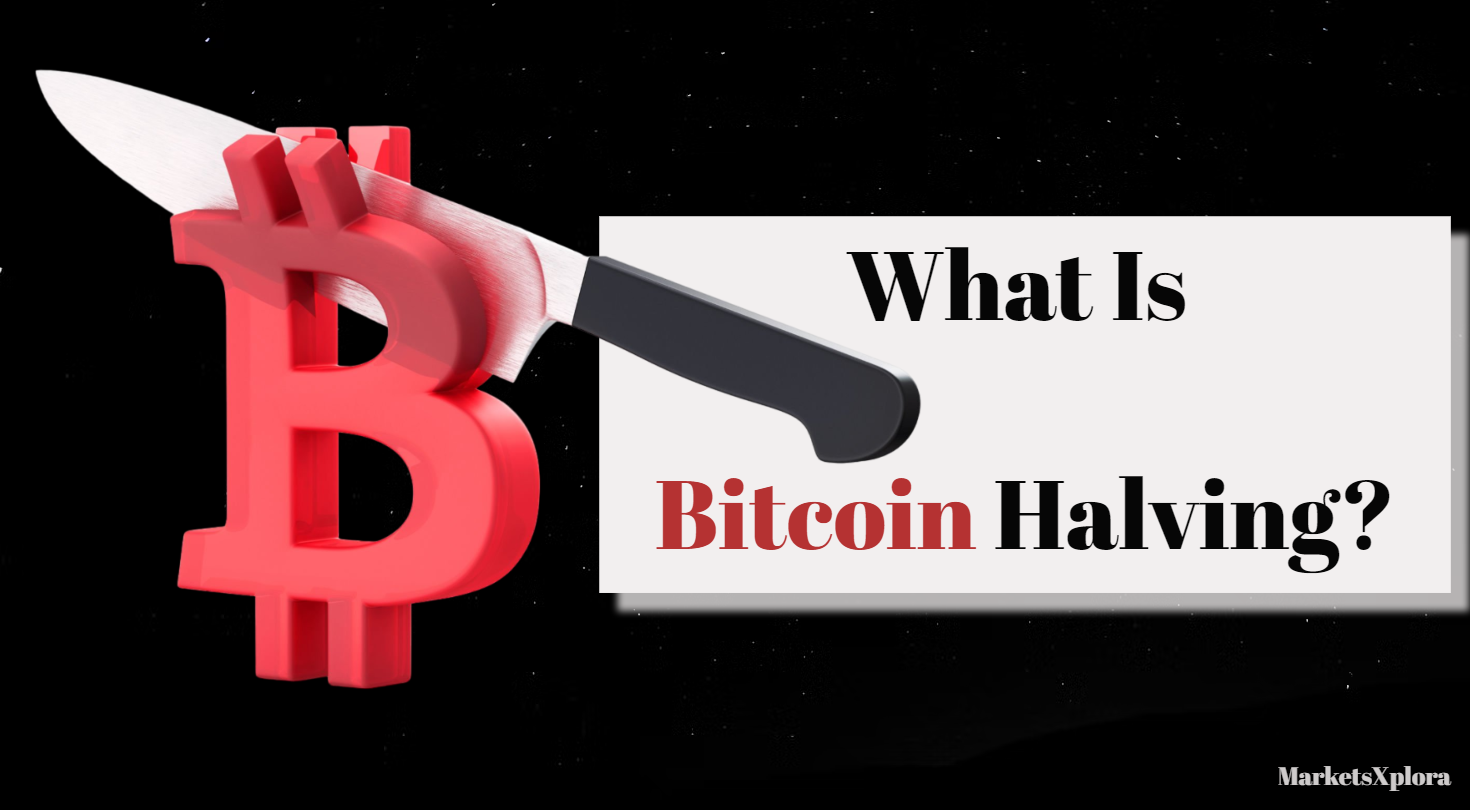
As the cryptocurrency world eagerly awaits the next major event in Bitcoin’s journey, the question on everyone’s mind is: What is Bitcoin Halving? Occurring roughly every four years, this highly anticipated phenomenon is set to unfold once again in 2024, with far-reaching implications for miners, investors, and the entire digital asset ecosystem.
This comprehensive guide will unravel the intricacies of Bitcoin Halving, addressing key questions such as:
- ✅ What exactly happens during a Bitcoin halving event?
- ✅ How often does Bitcoin halving occur, and when is the next one?
- ✅ What has been the impact of past Bitcoin halvings on price and mining?
- ✅ What are the potential effects of the 2024 halving on the crypto landscape?
- ✅ Is Bitcoin halving good or bad for the ecosystem?
Brace yourself as we embark on a journey through the heart of one of the most pivotal events in the cryptocurrency realm, exploring the delicate balance between scarcity, value, and the future of this groundbreaking financial innovation.
What is Bitcoin Halving?
Bitcoin halving is a pre-programmed event that occurs approximately every four years, reducing the reward miners receive for validating transactions and creating new blocks on the Bitcoin blockchain. Essentially, it cuts the rate at which new bitcoins are minted in half, making the cryptocurrency more scarce over time.’
To better understand Bitcoin halving means, let’s first look at how new bitcoins are created and distributed.
Bitcoin operates on a decentralized network powered by miners who use specialized computing hardware to solve complex mathematical problems. This process, known as “mining,” serves two purposes: it validates and records new transactions on the blockchain, and it introduces new bitcoins into circulation as a reward for the miners’ efforts.
Initially, when Bitcoin was launched in 2009, the mining reward was set at 50 bitcoins per block. However, the protocol was designed with a built-in mechanism called “halving” to control the supply of new bitcoins over time. Approximately every four years (or precisely every 210,000 blocks), the mining reward is automatically cut in half.
For example, in the first halving event in 2012, the mining reward was reduced from 50 BTC to 25 BTC per block. The second halving in 2016 saw the reward drop from 25 BTC to 12.5 BTC, and the most recent halving in 2020 brought it down to 6.25 BTC per block. This systematic reduction in mining rewards is what’s known as the “Bitcoin halving.”
Why Is the Halving Event Important?
This systematic reduction in mining rewards is a crucial mechanism for controlling Bitcoin’s supply and ensuring its long-term scarcity. As fewer new bitcoins are introduced into circulation with each halving, the rate of inflation decreases, making the existing supply more valuable over time.
Alongside the reduction in mining rewards, Bitcoin’s network also adjusts the mining difficulty level to maintain a consistent block production rate of approximately one block every 10 minutes. This adjustment is necessary because as the mining rewards decrease, some miners may choose to exit the network, potentially impacting the overall computing power dedicated to mining.
By periodically adjusting the mining difficulty, the Bitcoin protocol ensures that the rate of new block creation remains stable, regardless of the fluctuations in the number of miners or their collective computational power. This self-regulating mechanism helps maintain the integrity and security of the Bitcoin network, even as the economic incentives for miners evolve with each halving event.
Read also! Is Bitcoin Halving Good or Bad?
How Often is Bitcoin Halving?
Bitcoin halving occurs at a precise and predictable interval, taking place once every 210,000 blocks mined on the Bitcoin network. Given the average time required to mine a new block (approximately 10 minutes), this translates to a halving event roughly every four years.
The reasoning behind this fixed schedule lies in Bitcoin’s core design principles of transparency, predictability, and controlled supply. By baking the halving mechanism into the protocol’s code from the very beginning, Satoshi Nakamoto, the pseudonymous creator of Bitcoin, ensured that the cryptocurrency’s inflation rate would follow a predetermined and immutable trajectory.
This pre-programmed schedule serves several crucial purposes. First, it provides miners and investors with a clear roadmap, allowing them to plan and adjust their strategies accordingly. The certainty of when the next halving will occur eliminates surprises and instills confidence in the system’s reliability.
Furthermore, the quadrennial occurrence of halving events aligns with Bitcoin’s gradual transition from a rapidly inflating currency in its early days to a deflationary asset as it approaches its maximum supply of 21 million coins. This carefully calibrated schedule ensures a smooth and controlled distribution of new bitcoins, preventing excessive inflation while maintaining an adequate incentive for miners to secure the network.
By adhering to this fixed schedule, Bitcoin halving reinforces the cryptocurrency’s core value proposition of being a truly scarce and decentralized digital asset, immune to the whims of central authorities or external influences.
History of BTC Halving
Since its inception in 2009, Bitcoin has undergone three halving events, each marking a significant milestone in the digital currency’s journey. Let’s take a brief look at these past halvings and their impact on the Bitcoin ecosystem.
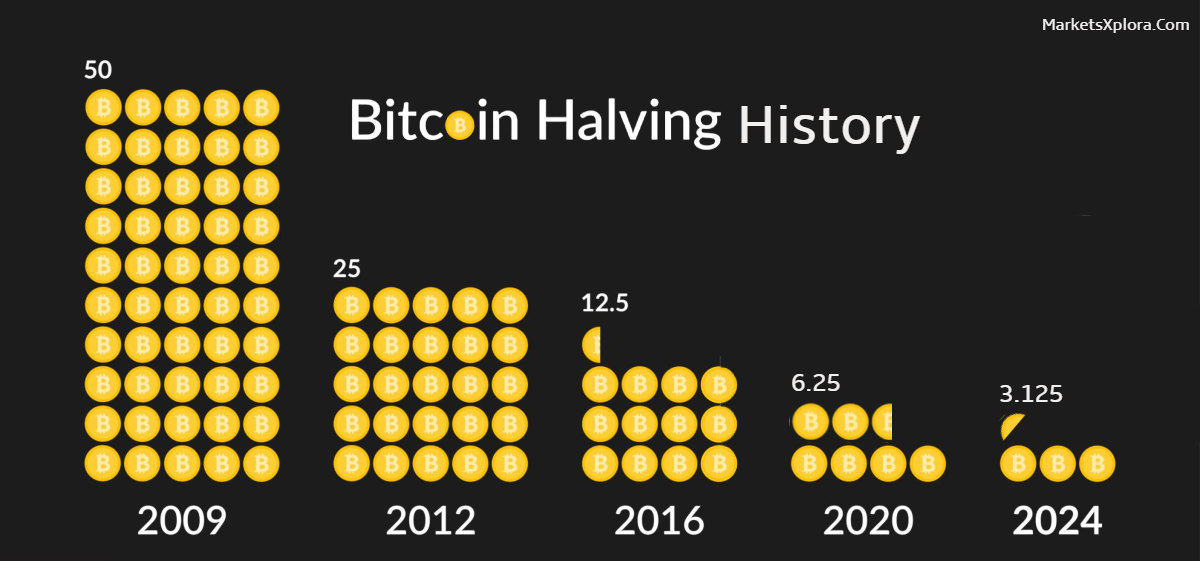
Bitcoin halving dates
- The first Bitcoin halving occurred on November 28, 2012, at block height 210,000. This event saw the mining reward slashed from 50 BTC to 25 BTC per block, effectively cutting the rate of new bitcoin issuance in half. While the impact on Bitcoin’s price wasn’t immediately apparent, this halving laid the foundation for the cryptocurrency’s future scarcity and potential value appreciation.
- The second halving took place on July 9, 2016, at block height 420,000. The mining reward was further reduced from 25 BTC to 12.5 BTC per block. This event coincided with a surge in Bitcoin’s popularity and adoption, leading to increased demand and a subsequent price rally. Within a year after the halving, Bitcoin’s value skyrocketed from around $650 to nearly $20,000, attracting global attention and ushering in a new era of mainstream interest in cryptocurrencies.
- The third halving event, which was the last Bitcoin halving, occurred on May 11, 2020, at block height 630,000, reducing the mining reward from 12.5 BTC to 6.25 BTC per block. This event unfolded amidst the COVID-19 pandemic, which disrupted global markets and economies. Despite the uncertain economic climate, Bitcoin’s price exhibited resilience, initially dipping but then recovering and continuing its upward trajectory in the following years.
Each halving event not only impacted Bitcoin’s price dynamics but also had profound implications for the mining ecosystem. As mining rewards were cut in half, miners faced increased costs and reduced profitability, leading to consolidation and the rise of large-scale mining operations. This shift towards industrialized mining has sparked debates around decentralization and the environmental impact of Bitcoin mining.
When is the Next Bitcoin Halving?
The cryptocurrency world is eagerly anticipating the next Bitcoin halving, a pivotal event that is expected to occur in April 2024. This upcoming halving will mark the fourth time the mining reward is cut in half since Bitcoin’s inception, further solidifying its position as a truly scarce digital asset.
According to calculations based on the current block production rate, the next Bitcoin halving is estimated to take place around April 24, 2024, at block height 840,000. At this point, the mining reward will be reduced from the current 6.25 BTC per block to 3.125 BTC, effectively halving the rate at which new bitcoins enter circulation.
How Does Bitcoin Halving Affect Price?
As the countdown to the 2024 halving event ticks closer, analysts and investors are bullish on Bitcoin’s price prospects. The recent launch of spot Bitcoin ETFs in the United States has driven significant inflows, with over $53 billion in reserves as of March 2024, up from $27.95 billion at their launch in January.
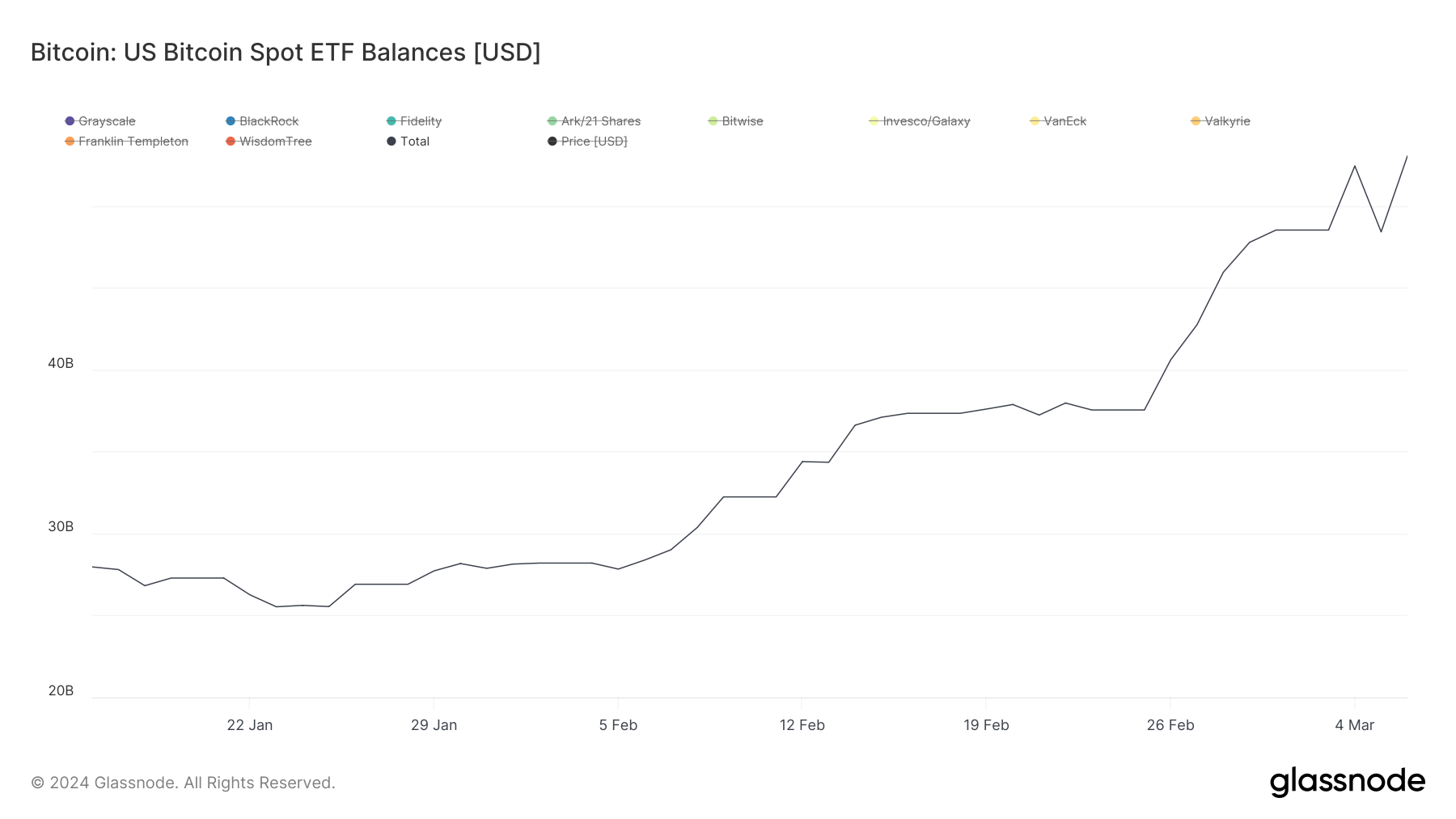
Historically, such increasing ETF inflows have corresponded with rising demand for the underlying asset, potentially setting the stage for a price rally.
On March 5, Bitcoin price reached a new all-time high above $69,200 after gaining 5% in the previous 24 hours. This Bitcoin’s price action bears striking similarities to the fractal observed before its November 2021 rally to $69,000.
Market analysts like Timothy Peterson predict that if the current accumulation trend sustains, Bitcoin could reach $100,000 by October 2024, riding on the wave of the halving-induced supply shock.
While some skeptics argue that the market has already priced in the halving event, technical analysis by traders like Jelle suggests that Bitcoin may be gearing up for a successful breakout similar to the one witnessed in 2020, potentially propelling prices beyond $75,000 in the coming months.
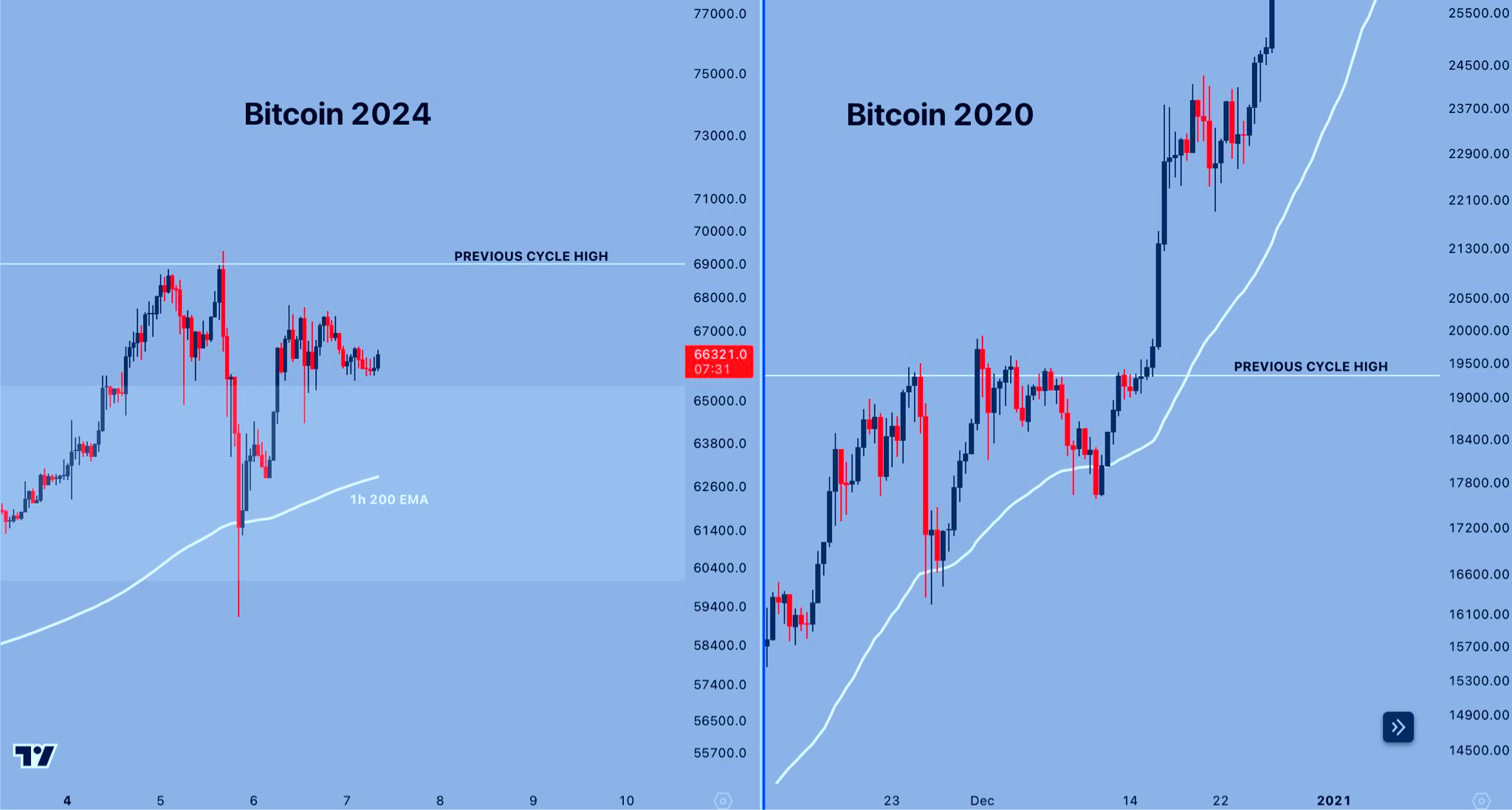
Regardless of the predictions, one thing is certain: the next Bitcoin halving will be a closely watched event, not just within the cryptocurrency community but also by traditional financial institutions and investors who are increasingly recognizing the potential of this pioneering digital asset.
What Happens After Bitcoin Halving?
While the halving event itself is a momentous occasion, its implications extend far beyond the immediate reduction in mining rewards. The aftermath of a Bitcoin halving can have ripple effects across the entire mining ecosystem, influencing profitability, mining pool dynamics, and even the overall security and decentralization of the network.
-
Mining profitability and adjustments
One of the most significant impacts is on mining profitability. With the mining reward slashed in half, individual miners and large-scale operations alike face a sudden decrease in their revenue streams. This profitability crunch often leads to a shakeout, where less efficient or undercapitalized miners are forced to exit the market, unable to sustain their operations profitably.
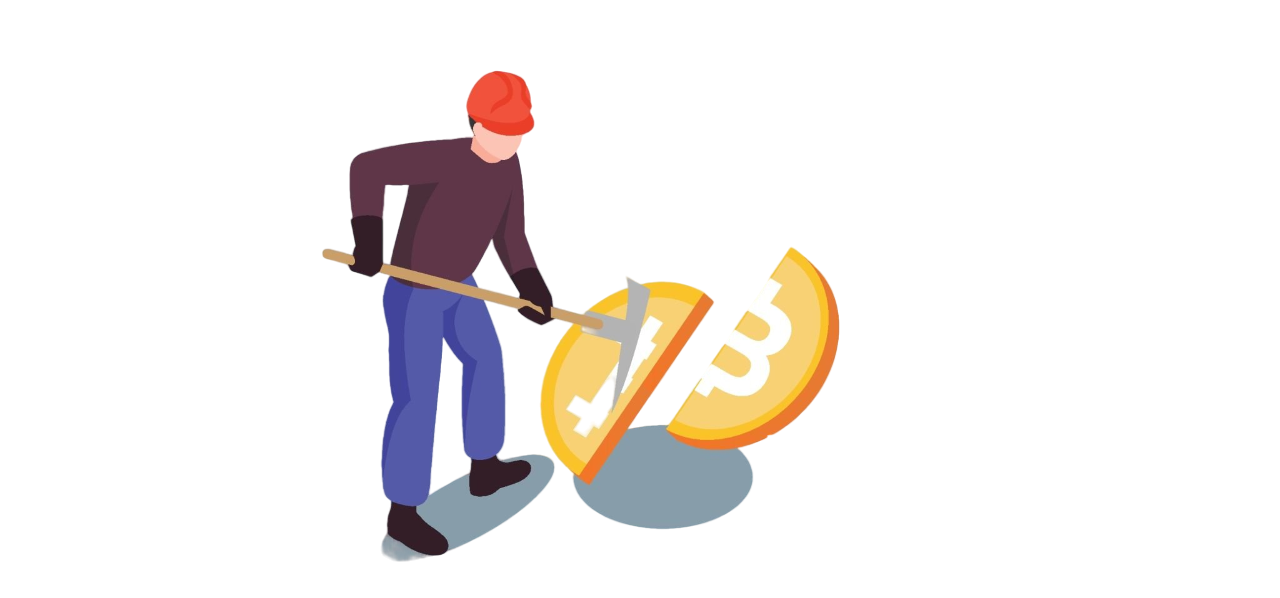
In response, the remaining miners must adapt and optimize their strategies to maintain profitability. This may involve upgrading to more energy-efficient mining hardware, relocating to regions with cheaper electricity costs, or joining forces with larger mining pools to increase their collective hashing power and share rewards more consistently.
-
Effects on mining pool dynamics
Speaking of mining pools, the post-halving period can also disrupt the dynamics within these collaborative mining groups. As smaller miners drop out, the distribution of hashing power among the remaining pools may shift, potentially concentrating more mining power in the hands of a few dominant players. This centralization of mining could raise concerns about the network’s decentralization, a core tenet of Bitcoin’s design.
-
Potential changes in network security and decentralization
However, the Bitcoin protocol has built-in mechanisms to counteract such centralization tendencies. After a halving, the network automatically adjusts the mining difficulty to maintain a consistent block production rate, regardless of the changes in the total hashing power. This adjustment ensures that the network remains secure and resistant to potential attacks, even as the mining landscape evolves.
Furthermore, the reduced mining rewards can act as a catalyst for innovation and efficiency improvements within the mining industry. Miners may be incentivized to explore more sustainable and cost-effective energy sources, such as renewable energy or waste heat recovery systems, to maintain their competitive edge.
While the immediate aftermath of a Bitcoin halving can be turbulent, the long-term implications often reinforce the cryptocurrency’s value proposition of scarcity and security. By design, the halving events ensure that the finite supply of bitcoins is distributed at a controlled and decreasing rate, preserving its status as a truly scarce and valuable digital asset.
Is Bitcoin Halving Good or Bad?
Whether Bitcoin halving is good or bad is a hotly debated topic without a simple answer. Investors tend to view it positively as reduced supply could drive up prices. But miners may face profitability challenges in the short term.
Truthfully, there are valid arguments on both sides. Rather than oversimplifying here, I’d recommend checking out our in-depth article “Is Bitcoin Halving Good or Bad? The Pros and Cons” for a balanced exploration of this complex issue. It covers the perspectives of different stakeholders and potential implications.
At the end of the day, the impact likely varies across the ecosystem. But our dedicated piece can give you a fuller understanding of the key points in this heated debate.
FAQs
- What is Bitcoin halving?
Bitcoin halving is a pre-programmed event that cuts the reward for mining new Bitcoin blocks in half, reducing the rate at which new bitcoins enter circulation.
- When is the next Bitcoin halving?
The next Bitcoin halving is estimated to occur around April 24, 2024, at block height 840,000.
- How often is Bitcoin halving?
Bitcoin halving occurs approximately every 4 years or precisely every 210,000 blocks mined.
- How does Bitcoin halving affect price?
Historically, Bitcoin’s price has tended to rally in the months leading up to a halving event as investors anticipate reduced supply. However, the post-halving price impact has varied, with some halvings followed by continued price increases and others by temporary dips.
- How does Bitcoin halving impact miners?
After a halving, miners face reduced revenue from block rewards, potentially squeezing profit margins and leading to industry consolidation as less efficient miners exit.
